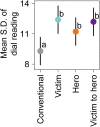Characters matter: How narratives shape affective responses to risk communication
- PMID: 31815957
- PMCID: PMC6901229
- DOI: 10.1371/journal.pone.0225968
Characters matter: How narratives shape affective responses to risk communication
Abstract
Introduction: Whereas scientists depend on the language of probability to relay information about hazards, risk communication may be more effective when embedding scientific information in narratives. The persuasive power of narratives is theorized to reside, in part, in narrative transportation.
Purpose: This study seeks to advance the science of stories in risk communication by measuring real-time affective responses as a proxy indicator for narrative transportation during science messages that present scientific information in the context of narrative.
Methods: This study employed a within-subjects design in which participants (n = 90) were exposed to eight science messages regarding flood risk. Conventional science messages using probability and certainty language represented two conditions. The remaining six conditions were narrative science messages that embedded the two conventional science messages within three story forms that manipulated the narrative mechanism of character selection. Informed by the Narrative Policy Framework, the characters portrayed in the narrative science messages were hero, victim, and victim-to-hero. Natural language processing techniques were applied to identify and rank hero and victim vocabularies from 45 resident interviews conducted in the study area; the resulting classified vocabulary was used to build each of the three story types. Affective response data were collected over 12 group sessions across three flood-prone communities in Montana. Dial response technology was used to capture continuous, second-by-second recording of participants' affective responses while listening to each of the eight science messages. Message order was randomized across sessions. ANOVA and three linear mixed-effects models were estimated to test our predictions.
Results: First, both probabilistic and certainty science language evoked negative affective responses with no statistical differences between them. Second, narrative science messages were associated with greater variance in affective responses than conventional science messages. Third, when characters are in action, variation in the narrative mechanism of character selection leads to significantly different affective responses. Hero and victim-to-hero characters elicit positive affective responses, while victim characters produce a slightly negative response.
Conclusions: In risk communication, characters matter in audience experience of narrative transportation as measured by affective responses.
Conflict of interest statement
The authors have declared that no competing interests exist.
Figures





Similar articles
-
Associations between narrative transportation, risk perception and behaviour intentions following narrative messages about skin cancer.Psychol Health. 2018 May;33(5):573-593. doi: 10.1080/08870446.2017.1380811. Epub 2017 Oct 4. Psychol Health. 2018. PMID: 28975805
-
Death narratives and cervical cancer: Impact of character death on narrative processing and HPV vaccination.Health Psychol. 2017 Dec;36(12):1173-1180. doi: 10.1037/hea0000498. Epub 2017 Jul 27. Health Psychol. 2017. PMID: 28749148
-
Framing Effects in Narrative and Non-Narrative Risk Messages.Risk Anal. 2015 Aug;35(8):1423-36. doi: 10.1111/risa.12368. Epub 2015 Mar 24. Risk Anal. 2015. PMID: 25809457
-
The narrative truth about scientific misinformation.Proc Natl Acad Sci U S A. 2021 Apr 13;118(15):e1914085117. doi: 10.1073/pnas.1914085117. Proc Natl Acad Sci U S A. 2021. PMID: 33837147 Free PMC article. Review.
-
The Use of Narrative in Science and Health Communication: A Scoping Review.Patient Educ Couns. 2023 Jul;112:107752. doi: 10.1016/j.pec.2023.107752. Epub 2023 Apr 13. Patient Educ Couns. 2023. PMID: 37068426
Cited by
-
Creating demand for unmet needs: Agile Storytelling.Front Health Serv. 2024 Oct 31;4:1376695. doi: 10.3389/frhs.2024.1376695. eCollection 2024. Front Health Serv. 2024. PMID: 39544454 Free PMC article.
-
Teaching Medical Students to Communicate Risks Like Military Intelligence Analysts.J Med Educ Curric Dev. 2024 Sep 27;11:23821205241278182. doi: 10.1177/23821205241278182. eCollection 2024 Jan-Dec. J Med Educ Curric Dev. 2024. PMID: 39381067 Free PMC article.
-
Persuasion with Precision: Using Natural Language Processing to Improve Instrument Fidelity for Risk Communication Experimental Treatments.J Mix Methods Res. 2023 Oct;17(4):373-395. doi: 10.1177/15586898221096934. Epub 2022 May 9. J Mix Methods Res. 2023. PMID: 39193005 Free PMC article.
-
COVID-19 memorable messages as internal narratives: stability and change over time.Policy Sci. 2024 Sep;57(3):519-538. doi: 10.1007/s11077-024-09538-5. Epub 2024 Jul 8. Policy Sci. 2024. PMID: 40575669
-
Visual policy narrative messaging improves COVID-19 vaccine uptake.PNAS Nexus. 2023 Apr 18;2(4):pgad080. doi: 10.1093/pnasnexus/pgad080. eCollection 2023 Apr. PNAS Nexus. 2023. PMID: 37096197 Free PMC article.
References
-
- Niles JD. Homo narrans: The poetics and anthropology of oral literature. Philadelphia: University of Pennsylvania Press; 1999.
-
- Weedon C. Identity and culture: Narratives of difference and belonging. Allen S, editor. Berkshire, England: Open University Press McGraw-Hill Education; 2004.
-
- Shanahan EA, McBeth MK, Hathaway PL. Narrative policy framework: The influence of media policy narratives on public opinion. Politics & Policy. 2011;39(3):373–400. 10.1111/j.1747-1346.2011.00295.x - DOI
-
- Green MC. Narratives and cancer communication. Journal of Communication. 2006;56(suppl_1):S163–S83. 10.1111/j.1460-2466.2006.00288.x - DOI
Publication types
MeSH terms
Associated data
LinkOut - more resources
Full Text Sources
Other Literature Sources

